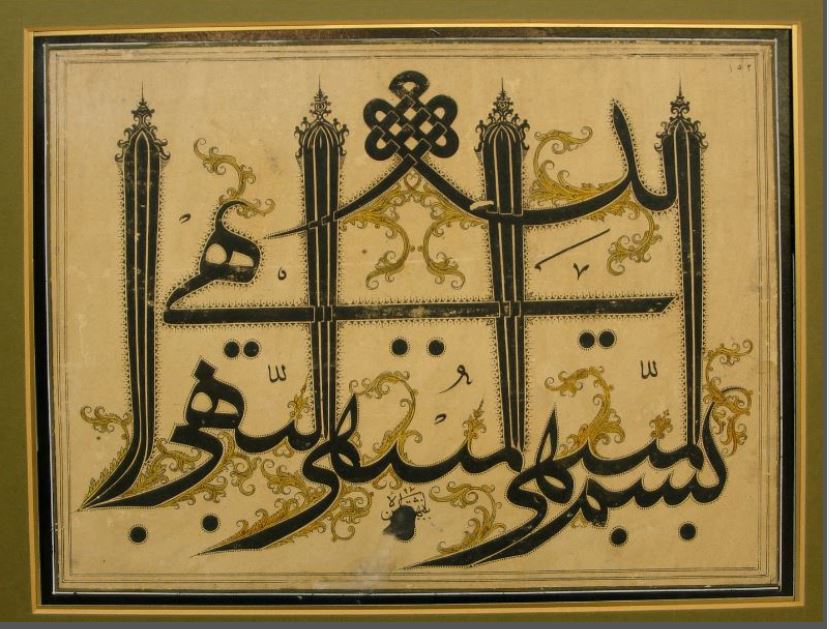
Calligraphy of Mishkin Qalam
میرزا حسین علی نورى بهاء الله
(1817-1892 CE)
Last major revision October 13th 2015.
A Select Alphabetical Listing of major Persian and Arabic writings of Baha'-Allah with occasional datings and other details and suggested abbreviations.
Stephen Lambden
Though in need of constant revision and updating, this webpage is based on extensive doctoral researches dating back to the 1980s and 1990s when I read, dated and summarized many of the major and some other scriptural Tablets of Bahā’-Allāh. Much of this research material remains in ms. or note form in folders and filing cabinets. In the list below I shall, for the most part, restrict myself to listing major titled scriptural alwah of Bahā’-Allāh. The vast quantity of writings addressed to the thousands of Babi, Baha'i and other recepients of Baha'i sacred writ from the founder of the religion, could not possibly be fully listed here; let alone full details be given respecting matters of dating contents, translations, recensions and locations, etc. There are likely to be something approaching 20,000 writings of Baha'-Allah commonly designed Lawh-i ___. Futher details can be found on the main page regarding such Tablets, addressed to leading Babis, Baha'is and others, many of which are commonly referred to as Lawh-i X.
The dating of Bahā’-Allāh's Writings.
The precise dating of many, perhaps most of the alwah of Bahā’-Allāh, is not known with certainty. Precise datings are, however, occasionally given for writings dating to the last few decades of Bahā’-Allāh's lifetime; most notably when written as if by his amanuensis Mirza Aqa Jan, Khadim-Allāh (`The Servant of God'). At the present time, lack of precise dating even applies to such major works as the Kitab-i iqan (`The Book of Certitude', c.1861), Kitab-i aqdas (`Most Holy Book', c. 1873) and Kitab ahdi (`The Book of [the] My Covenant', c.1891). It should be born in mind in this latter connection that certain writings of Baha'-Allah were compiled over months or years and exist in a preliminary, later or final recensions.
As an indication of dating the following periods within which Baha'i sacred writings were most likely written will be indicated as follows :
The Persian Babi years (1844-1852). TB1
- TB1 - 1260->1269 = 1844->1852. Writings of dating to the Persian years of the Bābī period (1844-1852) prior to the imprisonment in the notorious Siyāh Chāl ("Black Pit") dungeon in Tehran and the exile to Iraq. No reliable list of writings ascribed to Bahā'-Allāh during his earliest Bābī years is available. Various historical and scriptural sources do mention writings of these years though most do not seem to be extant.
The years in Iraq, Baghdad, Iraqi Kurdistan, etc (1853-1863). TB2.
- Arrival at Baghdad in late Jamadi al-Thani, 1269 = late March 1853.
- TB2A - dating to the first year or so in Iraq, Baghdad and elsewhere (1853-1854).
- TB2B- probably dating to the amost two years of the Iraq interregnum in Iraqi Kurdistan, Sulaymaniyya elsewhere (1854-1856). Baha-Allah left for Iraqi Kurdistan 12th Rajab 1270/ April 10th 1854 and arrived back in Baghdad on 12th Rajab 1272/March 19th 1856.
- TB2C - dating to the post-Sulaymaniyya years in Iraq, mostly Baghdad (March 1856-May 1863). Baha'-Allah left for Constantinople-Istanbul on the 14th Dhu'l-Qada, 1279 or May 3rd 1863 (so Zarandi, Tarikh I BW vols.).
The months at Constaninople-Istanbul in 1863. TB3.
- TB3 dating to the three or four months in Constantinople-Istanbul, 1863. After a lengthy, more than 3 month journey from 3rd Dhu'l-Qada, 1279 or April 22nd 1863, Baha'-Allah reached Constantinople-Istanbul on 1st Rabi al-Awwal, 1280/ August 16th 1863. According to Zarandi, he first dwelt for a month in the house of Shamsi Big or another residence in central Istanbul near the Hırka-i şerif / Khirqa Sharif (`Holy Cloak or Mantle' ) Mosque - one mantle was apparently brought to İstanbul by the Ottoman Sultan Abdülhamit-`Abd al-Hamid I in 1611 and another cloak housed in a mosque built for it in 1851 by Sultan Abd al-Majid (Abdülmecid, 1839–61). Subsequently Baha'-Allah lived for about 3 months in the nearby house of Visi Pasha close to the Sultan Muhammad II Fatih Mosque. At least five major alwah date from this period covering the journeys then the several months in the Ottoman capital.
The years in Adrianople-Edirne (December 1863-August 1868). TB4.
- Baha'-Allah arrived Adrianople-Edirne Rajab I 1280 or December 12th 1863.
- TB4A - Mid. 1863 and March 1866. The first Adrianople-Edirne period before the break with Mirza Yahya Nuri (c.1831-1914) who came to oppose Baha'-Allah's theophanic claims.
- TB4B - The second period of the emergent, independent Baha'i religion after the break with Mīrzā Yahyā Nuri in March 1866 until the move to the house of `Izzat Pāshā in August 1867 (around 1 year 6 months).
- TB4C- The third period. From the time of the move to the House of `Izzat Pasha (Aug. 1867) until the exile to Acre in Ottoman Palestine (Western Galilee, Aug. 1868). The firman of exile from Edirne decreed by Sultan `Abd al-Aziz, was dated 5th Rabi al-Thani 1285/26th July, 1868 and the arrival at Acre is dated 12th Jamad al-Awwal or August 31st. 1868.
The years in Ottoman Palestine, Acre, Bahji, etc (1868-1892). TB5.
A twenty-four year time period loosely divided up into five subdivisions :
- TB5A. The first years of incarceration in Acre. Arrived 12th Jamad al-Awwal or August 31st. 1868, first confined in the army barracks for 2 years, two months and five days or until the move around 4th Nov. 1870 to [1] the House of Malik (3 months), then [2] the House of Rabi`a (??), the [3] House of Mansur Khavvam (2-3 months) and the [4] House of the Rabi`a family (4 months).
- Death of Mirza Mihdi, son of Baha'-Allah 23rd Rabi al-Awal 1287/ June 23rd 1870.
- TB5B. From the time of the transfer to the House of the Christian merchant Udi Khammar in Sept. 1871 until the transfer to the front side of this property known as the House of `Abbud in late 1873 where the Kitab-i Aqdas was codified or compiled.
- TB5C. Out of the Acre confinement in June 1877 and the first, post Kitab-i Aqdas period. From the move to the `Garden of Ridvan' and the Mansion of Muhammad Pasha Safwat, Mazra'ih (4 miles north of Acre) until the June [Sept.] 1879 move to the `Palace of Udi Khammar' or Mansion of Bahji (3 kilometers n. of Acre).
- TB5D. At the Mansion of Bahji I, the early-mid. Bahji years, Sept. 1879-18XX.
- TB5E. At the Mansion of Bahji II : the mid.-final Bahji years 18XX until the passing of Baha'-Allah on May 29th 1892.
This dating schemata, along with occasional, admittedly imprecise, adjectives (early, mid. period or late) and /or suggested datings will occasionally be used. When a precise dating is known this will be clearly indicated.
Among the factors which future scholarship may need to take into account with dating issues are :
- Factors relating to the evolving handwriting, language, style, content and claims of Bahā’-Allāh himself.
- The possible implications of any introduction, colophon or attached seals or signitures to specific alwah.
- The handwriting and dating of the script of the amanuensis and/ or copyist.
- Factors within scriptural alwah and within historical sources relating, for example, to the biography and locations of recepient(s).
- Global mss. locations and related historical considerations.
Select URLs and Electronic Sources :
Abbreviations for the Mss. and Printed Sources referred to below :
- Ad`iyya = Ad`iyya-yi Hadrat-i Mahbub.
- Adʿīyah-ʾi Hadrat-i Maḥbūb : wa-fīhā mā tashtahīh al-anfus az munājāthā-yi sabāḥ va masāʾ va aʿyād va shifāʾ va siyām va amthālihā; fihristŕā dar ākhir mulāḥazah namāʾīd.Hofheim-Langenhain : Baháʾí-Verlag, 1980.
- A-Muluk = Alwāḥ-i nāzilh khiṭāb bi- mulūk wa ru'asā-yi arḍ, Tehran: MMMA, 1968/124 BE
- AQA = Āthār-i qalam-i a`lā. 8 vols. Bombay & Tehran: MMMA: Tehran, 1890-198?. rep. Vol. 1 (= K- Mubīn), Dundas, Canada, 1996/153 BE.
- AQA-M =
- Ayyam-i tisa = `Abd al-Ḥamīd, Ishraq Khāvarī (ed. and comp.) [Risala-yi] Ayyam-i tis`a (The Treatise regarding the Nine [Babi-Baha'i Holy Days]'). Tehran : MMMA., 121 BE/1965. 580 pp.
- BE. = Badi' Calendar, Baha'i Era. 1260AH/1844 CE >
- BPC. = Baha'i Publishing Committee.
- BPT. = Baha'i Publishing Trust.
- Collins = William P. Collins, A Bibliography of English Language Works on the Babi and Baha'i Faiths, 1844-1985. Oxford: George Ronald, 1990. Sect. I pp. 1-7 = `The Writings of Baha'u'llah', refers to 143 published items.
- Darya = Darya-yi danish.
- Ganj = `Abd al-Ḥamīd, Ishraq Khāvarī, Ganj-i shayigan ... A Persian survey of the writings of Baha'-Allah with numerous citations, datings and observations.
- INBA. = Iran National Baha'i Archives, numerous unpublished mss.
- INBMC. = Iran National Baha'i Archives Manuscript Collection, 100 + 5 vols.
- IQ. = Iqtidārāt va chand lawḥ-i dígār. n.p. [Bombay] 1310 A.H./1892-3.
- K- Mubīn = Rep. of AQA Vol. 1 (see above) = Kitab-i Mubīn., Dundas, Canada, 1996/153 BE.
- L-Hikma. = La'āli' al-ḥikma. 3 vols. (ed. Vahid Behmardi). vol 1.Brasil: Editoria Bahā'ī, 143BE/1987; Vol.2 Brasil: Editoria Bahā'ī, 146 BE/1990. Vol. 3, Brasil: Editoria Bahā'ī, 148 BE/1991.
- Ma’ida. [vols. 1-X] = `Abd al-Ḥamīd, Ishraq Khāvarī (ed.) Mā'ida-yi āsmānī. vols. 1, 4 & 7 (= writings of Bahā’-Allāh). Tehran: MMM., 128-9 BE.
- MAM. = Majmū`ah-yi alwāh-i mubāraka ḥaḍrat-i Bahā'u'llāh, Cairo: 1338 A.H. / 1919-20. Rep. BPT: Wilmette, Illinois, 1982.
- MMMA. = Mu'assih-yi Millí-yi Matbú'át-i Amrí. [Tehran] Iranian National Baha'i Publishing Trust'.
- Athar = Athar al-asrar, 5 vols. comp. Muhammad, Fadil-i Mazandarani,
- McEoin-Rituals = Denis MacEoin, Rituals in Babism and Bahá'ísm, British Academic Press 1994.
- MacEoin-Sources = Denis MacEoin, The Sources for Early Babi Doctrine and History. Leiden, Brill, 1992.
- McGlinn, Sen = `Leiden List: Bibliography to the Tablets of Bahá'u'lláh', 2009-2012 (ongoing on his personal website and the Baha'i Library Online).
- Nafahat = Nafahat al-Rahman (The sweet savor/ beath of the All-Merciful). Compilation of the writings of Bahá'u'lláh, Rio de Janiero: Editorial Bahá'í, 139/1982, 243 pp.
- Proclamation = The Proclamation of Baha'u'llah, Haifa: Baha'i World Centre, 1967.
- Rahiq = `Abd ak-Hamid Ishraq-Khavari, Rahiq-i Makhtum. 2 Vols., Tehran, 130-1/1973. (A commentary on Shoghi Effendi's Centennial Tablet (Lawh-i qarn) with many citations from alwah of Baha'-Allah.
- Taherzadeh, The Revelation of Baha'u'llah [= RB]' 4 vols. Oxford: George Ronald, 19XX-19XX
- Tasbih = `Abd al-Ḥamīd, Ishraq Khāvarī (comp.) Risāla Tasbih va Tahlil. Tehran: MMMA., 129/1973, 322 p.+ index. A Compilation of Baha'i obligatory prayers and other devitional works of Bahā'-Allāh. Rep. New Delhi, India, Baha'i Publishing Trust, 1982. 283 [-311 = index] pp.
-
TB = Tablets of Baha'u'llah revealed after the Kitab-i-Aqdas. Compiled by the research dept. of the Universal House of Justice. Haifa: Baha'i World Centre, 1978. vi. 276 pp. Trans. Habib Taherzadeh and others. Contains sixteen major Tablets of Baha'u'llah and excerpts from several others. Also, with corrections and index, Haifa: BWC., 1982. 298pp.
- TB* =Majmūʻahʼī az alvāḥ-i Jamāl-i Aqdas-i Abhá kih baʻd az kitāb-i aqdas nāzil shudah. Mu'assih-' Matbú'át-i Amrí Almān. Hofheim-Langenheim : Bahāʼī-Verl., 1980. 175-[19] pp. German printing of the Pesian and Arabic original texts of the above TB. 1st ed. 137 BE/1980. 2nd ed. 156/2000.
WRITINGS OF BAHA'-ALLAH IN PERSIAN AND/OR ARABIC 1852-1892.
Asl-i kullu al-khayr (`The Foundational Basis for Every Goodness') or "The Source of all Good").
This short work of Baha'-Allah is best known today by the paraphrastic title , "The Words of Wisdom", the Perso-Arabic title Asl-i kullu al-khayr might be more literally rendered `The Foundational Basis (asl) for Every Goodness (al-Khayr)'. It is essentially an Arabic compilation of religious maxims or definitions (cf. the Hidden Words) offering a seletion of succinct expressions of the quintessence of key relgio-spiritual qualities. This wholly Arabic work probably exists in several recensions dating from latter decades of Baha'-Allah's lifetime.
- INBMC 30: Add.
- "A Ms. in the hand of Abdu’l-Baha in the Ottoman archives is thought to have been acquired in 1868" (McGlinn).
- Majmu`a pp. 131-7?? Check.
- Ad`iyya-yi Hadrat-i Mahbub, 44-9.
- TB* : Item 10 pp. 92-94.
Translations : For details see Collins, and McGlinn, .
- TB : 153-157.
Az Bagh-i Ilahi (From The Divine Garden"). Persian and Arabic. Baghdad. c. 18XX.
See Ganj 66 (partially cited); Taherzadeh, 1: 218-20.
INBMC
Alwāḥ-i Badasht. TB1 (Lost?).
The writing or revelation of 81 (=9X9) of alwāḥ (scriptural Tablets) of Baha'=Allah to Bābīs present at the Conference of Badasht (Khurasan, Iran 1848) is mentioned in the Tarikh-i Zarandi (Dawn-Breakers, XXX). These alwāḥ apparently allotted new (presumably Bābī) names upon their recepients. They are not know to be still extant.
Bi Janan Jan Hami Daryaft (Add), Sulaymaniyya [Baghdad]. A Persian poetical writings dating to the early-mid. 1850s, c. 1855.
- Ma`ida, 4:176-8.
L-Bisharat (The Tablet of Glad-Tidings)
Translations : For details see Collins, pp. and McGlinn. Leiden List...
TB-1978 : 153-157.
Chahar vādī (The Four Valleys), addressed to Shaykh `Abd al-Rahman Khalis (d.1275/1858-9), a Talabani Shaykh, grandson of Mulla Mahmud Zangana (d. 1215/1800-1) of Bujan, and Qadiri Sufi leader and poet of Karkuk considered the founder of the Khalisiyya branch of the Qadiri Sufi order. Written c. 1857-8.
- Add
The Haft vādī (The Seven Valleys). See below `Seven Valleys'.
L-Hajj (Pilgrimage) : Tablets (alwah) for the performance of the Baha'i Pilgrimage Rituals.
- Add
- Add
The Hidden Words = Kalimat-i makunah (Arabic and Persian, c. 1857-8). Originally entitled Sahifa-yi Fatimiyya (The Fatimid Missive). According to its author this work in 153 succinct ethical maxims and mystical disclosures, is a summary or distillation of all that was revealed to previous prophets or messengers of God; "couched in the garment of brevity". The first half is in Arabic and the second in Persian. Hence the abbreviations HWA + HWP = The Hidden Words, Arabic or Persian.
- Kalimat-i maknūnih in MAM: 17-32 (Pt.1 Arabic) + 373-398 (Pt. 2 Persian).
Translations :
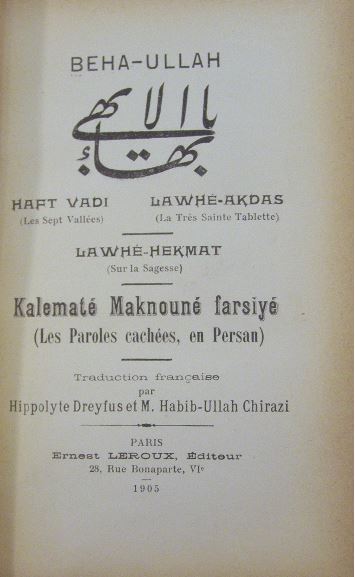
- 1905. Les paroles cachées, en persan. Trans. Hippolyte Dreyfus; Mirza Habib-Ullah Chirazi. Paris: Ernest Leroux, 1905. 116pp. Within the volume are : Kalemate Maknoune farsiye (Les Paroles cachees, en Persan) [Haft Vadi (Les Sept Vallees), Lawhe-Akdas (la Tres Sainte Tablette) and Lawhe-Hekmat (Sur la Sagesse).
- 1911. Hidden Words. Words of wisdom and communes from "the supreme pen" of Baha'u'llah. Translated by Mirza Ameen U. Fareed. Unity Press: London, 1911. 44pp.
- 1915. Hidden words / from the Arabic ; from "The Supreme Pen" of Bahaʾuʾllah.
London, 1915. Copy in British Library. - 1923. The Hidden Words of Baha'u'llah. Early trans. Shoghi Effendi. London : The Baha'i Assembly, 1923. Within `The Hidden Words, Words of Wisdoim, Prayers'. 90pp.
- 1929. The Hidden Words of Baha'u'llah. Revised trans. Shoghi Effendi "with the assistance some English friends" [= George Townshend, John Esslemont, Ethel Rosenburg]. London : National Spiritual Assembly of the Baha'is of Great Britian and Northern Ireland. 1929. 55pp. See Collins, XX.
- 19XX
Jawāhir al-asrār (The Essences [Gems] of the Mysteries). Arabic, c. 1860-1.
Jawahir =
- [1] Jawāhir al-asrār. INBMC 46:1ff
- [2] Jawāhir al-asrār. INBMC 99.
- [3] Jawāhir al-asrār (The Essences of the Mysteries). AQA 3:4-88
al-Kalimat al-firdawsiyah (The Words of Paradise).
al-Kalimat al-firdawsiyah, majmu'at alwah Baha' Allah - see compilations below.

KINGS, RULERS, RELIGIOUS LEADERS ...
Like the Prophet Muhammad (d.632 CE) and his near contemporary, the Bab (d.1859 CE), Baha'-Allah wrote to several of the kings, rulers or religious leaders of his day, sometimes individually as well as collectively. He called these persons to faith in him as the universal, eschatological saviour and expressed advice for global reform. Baha'-Allah regraded these communications as poweful expressions of divine judgement.
Individually :
Lawḥ-i `Abd al-Azīz wa wukala ("Tablet to `Abd al-Azīz and his ministers"). TB3. Constantinople, 1863. Text currently lost, unavailable.
The Tablet to the Giovanni Maria Mastai-Ferretti, Pope Pius IX (born May 13, 1792, Senigallia, Papal States; reigned 16 June 1846 - d. Vatican City, Feb 7th, 1878). Beatified September 3, 2000.
L-Pāp = Lawḥ-i. Pāp (Tablet to the Pope Pius IX) c. 1869.
- Lawḥ-i. Pāp in A. Muluk:73-90.
- Lawh-i [Keçecizade Mehmed] Fu'ad Pasha (b. Istanbul, 1815-d. Nice, France, 12th Feb. 1869), Turkish Foreign Minister (1850s and 1860s) + Grand Vizier (1861-3+1863-6). Also known as the Lawh-i Kaf Za (K-Z = Kazim Samandar). c. 1869-70. Introduction.
- Translations of the Lawh-i [Keçecizade Mehmed] Fu'ad Pasha.
- The Lawh-i Ra'is ("Tablet to the Premier-Leader") is a Persian scriptural Tablet composed in late 1868 or 9. Introduction.
- PDf. Mss. and printed editions of the original text of the Lawh-i Ra'is.
L-Vikturyia = The Tablet to Queen [Alexandrina] Victoria (24 May 1819 – 22 January 1901), Queen from 1837 and later Empress of India.
- Lawḥ-i Vikturiya, A-Muluk:131-141.
L-Malik R = The Tablet to the Czar of Russia Nicolaevitch Alexander II (b. Moscow, XXXX; r. 2nd March 1855 – 13th March 1881).
- Lawḥ-i. Malik-i Rūs. A. Muluk:121-128.
L-Rothschild [representing Jews and Judaism] Lost ?? A Tablet to a prominent Jew. Apparently to be delivered by a Persian Baha'i of Jewish background to a Paris connected member of the Rosenthal or Rothschild family; perhaps the prominent Jewish benefactor and Zionist Edmund James de Rothschild (1845-1934) who had very close links with Ottoman Palestine. He visited Palestine in 1895 and several times subsequently.
Collectively :
S-Muluk = Sūrat al-mulūk (The Surah of the Kings).
- Sūrat al-mulūk (The Surah of the Kings). A-Muluk: 3-69.
S-Haykal = The Surat al-haykal (Surah of the Temple).
- Sūrah al-haykal. Bombay, 1891.
- XXX
Translations:
- XX
- XX
Compilations of Scriptural Tablets to Kings, Rulers and Religious Leaders.
- A-Muluk = Alwāḥ-i nāzilh khiṭāb bi- mulūk wa ru'asā-yi arḍ, Tehran: MMMA, 1968/124 BE.
- Alváḥ-i názilih khaṭáb bi Saláṭín va Umará-yi arḍ : Tablets of Bahá'u'lláh addressed to the kings of the Earth and the world's religious leaders. ed. Hushang Goharriz, [Madrid] Fundación Nehal D.L. 2011. 510pp.
Translations:
- The proclamation of Baháulláh to the kings and leaders of the world. Baháʾuʾlláh, 1817-1892. Haifa: : Bahá í World Centre, 1972
♦

KITAB = Book(s).
K-`Ahdi = `The Book of My Covenant', The Will and Testament of Baha'-Allah in which he appoints his eldest son `Abd al-Baha' to be his successor. Persian + Ar. Acre-Bahji, c. 1891.
- Kitab al-Ahdi (Ar.) Kitab-i ahd (Per.), The Book of the Covenant).
- MAM : 399-403.
Translations :
- Kitab-El-Ah'd, Book of the Covenant, the Will and Testament of Baha'o'llah . Chicago:
Bahai Publishing Society, 1913. [3) pp. Collins 1.76, p.4. - The Covenant of Baha'u'llah. London : pp.
- 'Kitab-i-`Ahd (Book of the Covenant). TB: Item 15. Trans. Shoghi Effendi, Taherzadeh, etc., pp. 217-223[4].
The Kitab-i iqan (`The Book of Certitude', Baghdad, c. 1862).
K- īqān* [Egypt, 1934]
- Add
K-iqan [Karachi, 1990]
- كتاب مستطاب ايقان : قل هذا يوم فيه تمت الحجة وظهرات الكلمة ولاح البرهان، إنه يدعوكم بما ينفعكم ويأمركم بما يقربكم الى الله مالك الأديان. = Kitāb-i mustaṭāb-i īqān : qul hādhā yawmun fīhi tammat al-hujjah wa-ẓaharat al-kalimah wa-lāḥa al-burhān, innahu yadʻūkum bi-mā yanfaʻakum wa-yaʼmurukum bi-mā yuqribukum ilá Allāh mālik al-aydān. Karachī : Muʼassasa-i Maṭbūʻāt-i Millī-yi Bahāʼiyyan-i Pakistan, 1990. 199 pp. Reprint of the Cairo 1934 edition.
Translations:
- 1904. Le livre de la certitude [Kitab-el-Ikan], un des livres sacrés du béhaïsme Hippolyte Dreyfus; Mirza Ḥabib Allah Kaani Chirazi Paris : E. Leroux, 1904. [In Series: Bibliothèque orientale elzévirienne, LXXIX.] 1 vol. VII-212 pp.
- L'Oeuvre de Bahâou'llâh. [3], Le Livre de la certitude (Kitabou'l Iqan). Paris : Ernest Leroux, 1928.
K- īqān tr.
- Kitáb-i-Iqán: The Book of Certitude (tr. Shoghi Effendi). London: BPT.,1961. 167pp.
K-iqan [Germany, 1980]
- Kitāb-i īqān, Hofheim-Langenhain: Bahā'ī-Verlag, 1980/ 136 BE (= rep.
Further Selected translations and commentaries, etc.
ʻAbd al-Ḥamīd Ishrāq Khāvarī,
- Kitāb-i qāmūs-i īqān, 4 vols. Tehran: XXX, 128, BE./1972. A lexicon and commentary upon the Persian text of the Kitāb-i īqān.
Hooper C Dunbar,
- A companion to the study of the Kitáb-i-Íqán. Oxford : George Ronald, 1998.
al-Kitab al-aqdas = (Per.) Kitab-i aqdas (`The Most Holy Book', Acre-Bahji, c. 1873). Arabic.
كتاب اقدس
- Kitab-i aqdas. Lithograph, 187?
- Kitab-i aqdas. Bombay : Maṭbaʿ al-nāṣirī, 1896. Compy in British Library.
- Kitāb-i aqdas translated by Sayyid Muḥammad Varith Hamdānī. Ist ed. Pakistan : Bahāʾī Publishing Trust, 1997.
Aleksandr Grigor’evich Tumanskiy (1861-1891). Text and Russian trans. along with other alwah and miscellany. See http://www.iranicaonline.org/articles/tumanski-aleksandr-grigorevich
- Kitabe Akdes, in Zapiski Imperatorskoy Academii Nauk St. Petersburg, 8th series, vol. 3, no. 6, 1899.
Translations into European languages.
Anton Haddad
- 1899?. Perhaps the earliest English translation. Privatrely circulated in the USA from the 1890s (never printed).
Earl Elder and William Miller - A Christian missionary edition and trans. which is sometimes inelegant and inaccurate.
- Al-Kitāb al-Aqdas or The most Holy Book. Ed and trans. Earl Edgar Elder; William MacE Miller, (In the Series: Oriental Translation Fund. N.S, vol. 38). London : The Royal Asiatic society, 1961. 74pp.
Baha'i World Centre, Haifa, Israel.
- The Kitáb-i-Aqdas. The Most Holy Book. Haifa: BWC, 1992/5.
- كتاب اقدس . Kitāb-i-aqdas / [Baháʾuʾlláh].Haifa : Baháʾí World Centre, 1995. Israel Haifa.
K-Badi`(The New-Wondrous-Revolutionary Book) (Edirne, c. 1867). Persian.
- Kitāb-i badī`nazil az sama'-i mashiyyat Hadrat-i Baha'-Allah. Printed from a facsimile edition/ copy of ms. in the hand of Zayn al-Muqarrabin [dated 13th of Rabi` al-Awwal, 1286 = 23rd June, 1869]. Reprint, Prague: Zero Palm Press, 148 BE/1992. 419 + viii pp.
- Complete Persian ms. in the possession of the XXX and Mary Koucheckzadeh Baha'i family.
- Kitab-i badi` nazil az qalam-i hadrat-i Baha'u'llah. Mu'assah-' Matbú'át-i Amrí Almān. Hofheim-Langenheim : Bahāʼī-Verlag, 165 BE/2008. 200pp. + Index, 201-213 + 8pp. 1st. German printing of the Persian primarily based on a ms. in the hand of Zayn al-Muqarrabin
♦
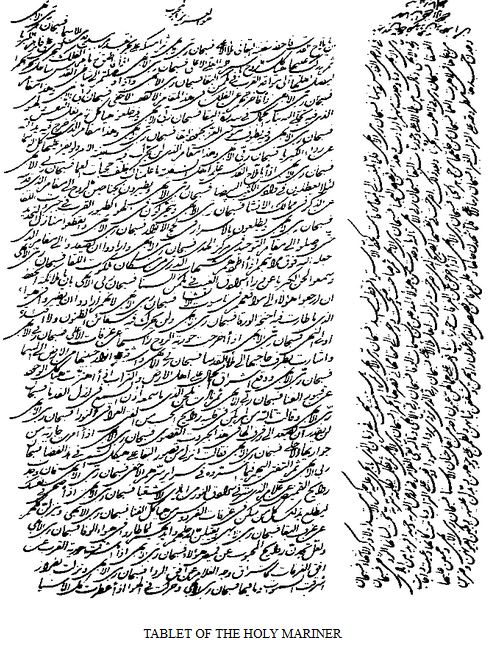
LAWH (Pl.) ALWAH = SELECT SCRIPTURAL TABLETS, EPISTLES OR LETTERS.
L- : Lawḥ (pl. alwāḥ) ("Scriptural Tablet”).
L-Aqdas = Lawḥ-i aqdas. (The Most Holy Tablet). c. 1875? Arabic. Also popularly known in the west as the 'Tablet to the Christians'.
- Lawḥ-i aqdas in
Translations :
- Lawḥ-i-Aqdas.
- Lawḥ-i-Aqdas.
- Lawḥ-i-Aqdas.
Michael W Sours, A Study of Bahá'u'lláh's Tablet to the Christians Oxford : Oneworld, 1990. 212pp. A study of the Lawḥ-i-Aqdas.
L-`Ayyūb = The Tablet of Job or Sūrat al-ṣabr (The Surah of Patience ).
- Lawḥ-i `Ayyūb or Sūrat al-ṣabr. in Ma’ida IV: 282-313.
L-Baha’ =
- Lawḥ-i Bahā’ (The Tabet of Baha', Glory-Splendor-Beauty). Haifa mss. INBMC 35:70-81.
L-Khaliq (the Creator). TB4? =
- `O Thou Creator!’ ms. (trans. Hebrew University, Jerusalem).
L-Banu Qurayza (Contains comments upon the slaughter of this Jewish tribe at the time of Muhammad). TB4 = Acre period. 1870s ?
- Lawḥ-i Banu Qurayza : Text in IQ :
L-Hajji Mirza Hadi Qazvini =
- Lawh-i Ḥajjī Mullā Hadī Qazvīnī. MAM:346-62.
L-Hikmat = ("The Tablet of Wisdom"). TB4.
- Lawḥ-i Ḥikmat (The Tablet of Wisdom). MAM: 37-53.
- Trans. Taherzadeh+ TB:
L-Howdaj-Samsun = Tablet of the Howdah or Lawḥ-i Samsun. TB3. Written near Samsun en route to Edirne (Adrianople) at the request of Mīrzā Aqā-Jān, in August 1863.
- L-Howdaj-Samsun
- L-Howdaj-Samsun
- Trans. Lambden on this website.
L-Hurufat =
- [Tafsīr] L- Ḥurūfāt-i muqaṭṭa`a (The Commenatry upon the Isolated Letters [of the Qur'an]) Haifa mss. [2] INBMC 36:212-242 ; [3] Mā’ida 4:49-86
L-Ibn = (The Tablet Regarding the Son of Man [Jesus])
- Lawh-i Ibn-I Insān. IQ: 93ff.
Lawh-i Ibn-i dhi`b (Epistle to the Son of the Wolf), c.1890. Persian with many Arabic citations.
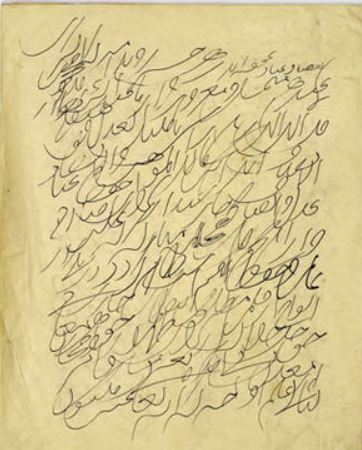
Leaf from a ms. of the above work in `revelation writing' in the hand of Mirza Aqa Jan Khadim-Allah.
- Lawh-i Ibn-i dhi`b or Lawh-i Shaykh
- Lawḥ-i Khiṭāb bi-Shaykh Muḥammad Taqíī Mujtahid-i Iṣfahānī ma`ruf bi Najafī. Cairo: nd. 1338/1919-20.
- Lawh-i mubarak khitab bih Shaykh Muhammad Taqi-yi Mujtahid Isfahani, ma`ruf bih Najafi [= Lawh-i Ibn-i dhi`b]. np. nd. 214 + 1 [Errata] pp.
- Lawh-i Ibn-i dhi`b
- Lawḥ- Ibn-i Dhi’b (“Epistle to the son of the Wolf” = ESW L-Sultan = (Nāṣir al Dīn Shāh) in A. Muluk: 145-201.
Translations.
Hippolyte Dreyfus-Barney (1873 -1928).
- 1913. L'épitre au fils du loup, par Bahâouʼllâh ; traduction française [du persan] par Hippolyte Dreyfus. Paris : Honoré Champion, 1913. xvii, [1], 185 pp.
Julie Chanler (1882 – 1961) + Mirza Ahmad Sohrab ( ),
- 1928 . The Epistle to the Son of the Wolf. trans. Julie Chanler. New York City: Baha'i Publishing Committee, 1928.140pp. Introduction by Horace Holley (pp. v-vi). Basically a revised translation of the 1913 French translation by Dreyfus (see above). Mirza Ahmad Sohrab compared the Dreyfus-Chanler translation with "an authoratative copy of the original Persian text".
Shoghi Effendi (d. 1957).
- Epistle to the Son of the Wolf (tr. Shoghi Effendi). Wilmette: BPT, rev. ed., 1971(76).
- Epistle to the Son of the Wolf. trans. Shoghi Effendi.
♦
L-Khātam =
- Lawḥ-i Khātam al-nabiyyūn (Tablet on the significance of the Seal-Acme of the Prophets"). (mss.).
L-Kullu al-Ta`am (The Tablet of All Food). TB2A. c. 1854.
لوح كُلُّ الطَّعَامِ
Probably written in late 1853 or early 1854 (1270 AH), this wholly Arabic Tablet is essentially a non-literal Bābī inspired commentary upon Qur'ān 3: [87]93. It was written in response to a question about this qur'anic verse by Ḥajjī Mīrzā Kamāl al-Dīn Narāqī (d. Narāq c.1278-9/1881) which had been inadequately replied to by Mīrzā Yaḥyā Nūrī (c.1831-1914), the then nominal head of the Bābī community.
- Lawh-i Kullu al-Ta`am
- L-i Kullu al-Ta`am
Translation :
Full Eng. trans. and commentary Stephen Lambden, A Tablet of Bahā'-Allāh of the early Iraq Period: The Tablet of All Food (Lawḥ-i kull al-ṭa`ām) in Bahá'í Studies Bulletin 3:1 - on this website...
See also : Ishrāq Khāvarī, Ganj. 8-10 ; cf. BW XIV: 622-3; Rahiq II: XXXX' Shoghi Effendi, GPB:116-7; Taherzadeh RB I:55-60; Balyuzi BKG: 112-3.
L-Qabl. =
- Lawḥ-i qabl-i ādam (Tablet Regarding the pre-Islamic Period). IQ: 68-78 cf. partial tr. SE* GWB: LXXXVII.
L-Mawlūd =
- Lawḥ- i mawlūd- i ism- I a`ẓam ("Tablet in Celebration of the Birthday of the Greatest Name [Baha;-Allah]. Ayyām- i tis`a, 48-51.
L-Naqus = Lawḥ-i Nāqūs ("Tablet of the Bell"). TB3. 1863.
Also known as the Subhanaka yā-hū ("Praised be Thou, O He").
Text in
- Ada'iyih-M:141-153;
- Ayyam-i T.,:100-106.
Translations :
- Add
- `Ali Kuli Khan + Marzieh Gail :
- MacEoin :
- Lambden :
L-Mallaḥ al-quds ("Tablet of the Holy Mariner"), TB2C. c. 186X.
- Lawḥ-i Mallaḥ al-quds. In
Translations:
- The Tablet of the Holy Mariner = Lawh-i-Mallah al-Quds...Fire Tablet= Lawh-i-Qad Ihtaraqa'l-Mukhlisin. [Germany] Hofheim-Langenhain: Baha'i-Verlag, 1985. 84 pp. See also Collins : 1.5, 1.30-1.34, r.107-1. 108, 4. 133.
- The Tablet of the Holy Mariner. The Tablet of Fire . n.p. [Germany: Sa'fd Mu'tamid] n. d.
[1980]. 80 pp .
L-Ra'is (Tablet to the Premier-Leader). A Persian Tablet addressed to the Turkish Premier `Ali Pasha late 1868 or 1869.
L-Zuhur (Tablet of Manifestation or the Theophany).
- Lawḥ-i Zuhur.
The Mathnavi-yi Mubārak (The Blessed Mathnavi), a Persian mathnavi poem in 318 verses, was probably written in Baghdad or Constantinople in 1863. This work is referred to in the Adrianople-Edirne periopd 1283/1866-7 Persian book, the Kitab-i badi` of Baha'-Allah (see above). It was apparently written for Ḥājī Siyyid `Alī Akbar-i Dahajī. TB3. Constaniople,1863.

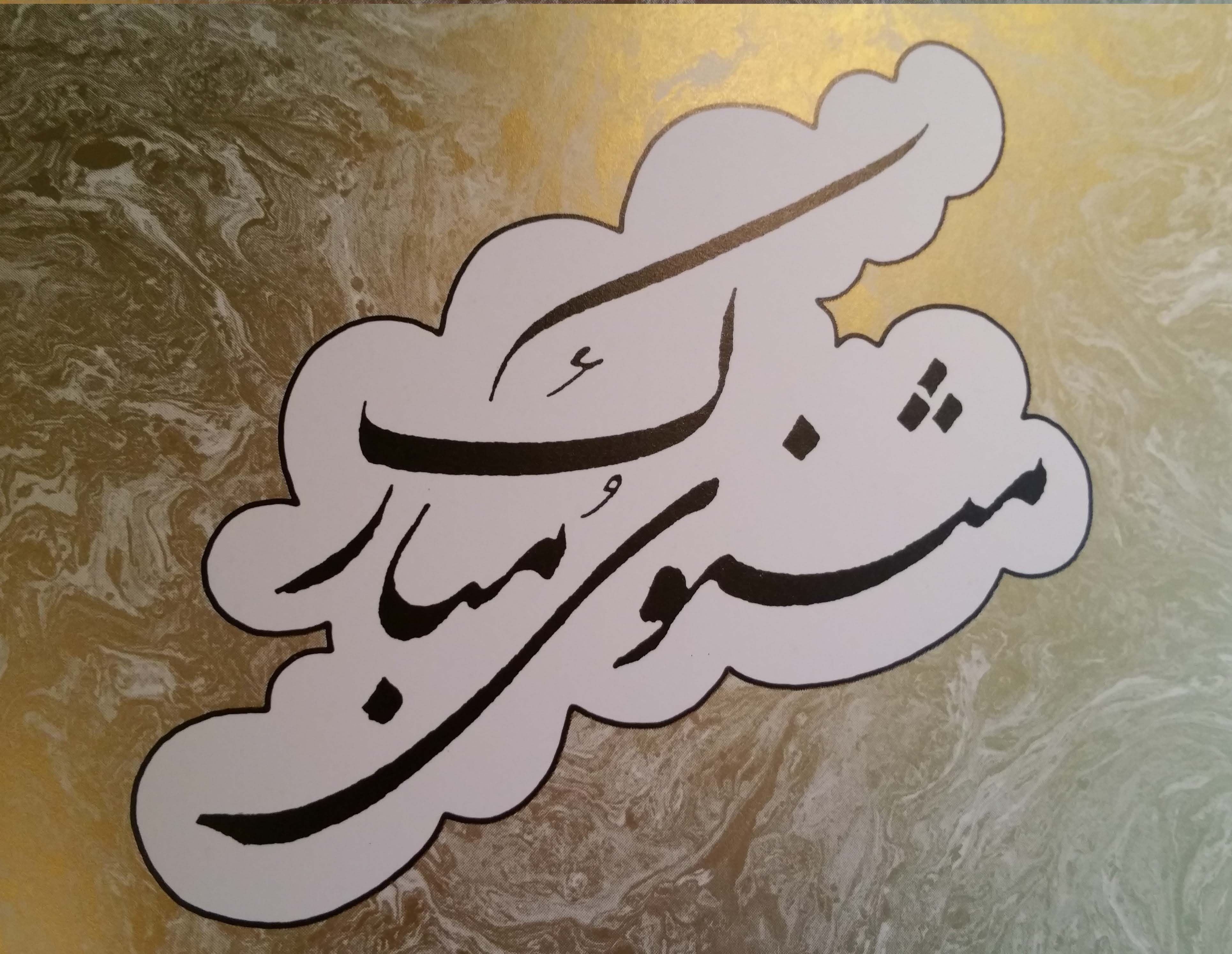
Mīrzā Husayn Isfahani Mishkīn Qalam
- Mathnavi-yi mubārak. Ms. in the hand of the Baha'i scribe Zayn al-Muqarrabin dated 8th Ramadan, 1299 or 24th July 1882 CE.
- 1905. Mathnavi-yi mubārak. Indian ed. in the script of Mīrzā Husayn Isfahani Mishkīn Qalam, the Musk-Scented Pen (b. Isfahan c. 1826-d. Haifa, 1912).
- 1914 Mathnavi-yi mubārak. Printed with the Haft Vadi (Seven Valleys) and Kalimat-i maknuna (Hidden Words) of Baha'-Allah in Cairo in 1333 AH/1914 CE.
- 1932 = 89 BE. Mathnavi-yi mubārak. [Tehran?] Jellygraph ed. with poems of Tahira Qurrat al-`Ayn (d. 1852) and an Istidlaliyya (Testimony Book) and poems of the Baha'i poet Mirza Na'im of Siddih [Isfahan] ( ).
- 1953 =110 BE. Mathnavi-yi mubārak. printed in a small 54 page volume in Delhi, India.
- 1964 =121 BE. Mathnavi-yi mubārak in the Tehran ed. of AQA vol. III.
- 1992. Mathnavi-yi mubārak. Bahāʼ Allāh; Prologemenon Waḥīd Raʼfī (pp. 1-5) Based on and reproduces a forty or so page calligraphic rendering in the script of Mīrzā Husayn, Mishkīn Qalam held at the Baha'i World Centre, Haifa, Israel. 1992. pp. vii+ unpaginated. Contains a useful introduction in Persian by Waḥīd Raʼfī dated May 1992.
Translations :
- 1997. El poema del bendito = (Masnaví Mubarak). ed. trans. Juan A Guzmán. [Series: 27.'"> Colección de Poesía "Juan Ramón Jimémez", 27.] Huelva : Excma. Diputación Provincial de Huelva, D.L. 1997. A "versión literaria y prólogo de, Juan A. Guzmán". 52pp.
- 19XX. Mathnavi-yi Mubarak. English trans. Frank Lewis (Univ. Chicago).
Qasida (Ode) =
- al-Qaṣīdah `izz al-warqa’iyya (The Mighty Ode of the Dove) Ms. Haifa AQA 3:196-213.
Rashh = Rashḥ-i `amā’ (The Sprinking of the Theophanic Cloud). Tehran, c. 1852-3.
Opening hemistich: رَشْح عَمَاء از جَزب مَا مِيرِزَد
Most Bahā'ī sources regard this 19 or more (20/21) line poetical composition (qaṣīdih) as the earliest extant piece of divine revelation coming from the person of Bahā'-Allāh at the time of his four month imprisonment (Oct./Nov. 1852--Jan./Feb 1853?) in the Siyāh Chāl (Black Pit) dungeon in Tehran in the (Bābi-Bahā'ī) year nine 9 = 1269 AH (began15th Oct. 1852- ended 4th Oct. 1853). Versions of the (developing) text can be found scattered in various mss. and a few printed sources including, for example :
- Rashḥ-i `amā’
- Rashḥ-i `amā’. Haifa typsescript in the hand of Zayn al-Muqarrabīn
- Rashḥ-i `amā’ INBMC 36:460-1.
- Rashḥ-i `amā’. Ma’ida 4:184-6. trans. Lambden. BSB 2/1 (1983): 4-114.
- Rashḥ-i `amā’. Stephen Lambden, revised translations and commentary on this Website.
Salat (Daily Obligatory Prayers).
For contextual and other details see McEoin, Rituals, 38-40. Synopsis and Cod.,
[Pre-] Kitab-i Aqdas (c. 1873) Salat : three rak`as three times per day.
Later forms of the Baha'i Salat (now in use globally) :
- Short. P&M* : + Tasbih : 21-22. Trans. P&M : + Baha'i Prayers ( ).
- Medium. P&M* : + Tasbih : 16-21. Trans. P&M : + Baha'i Prayers ( ).
- Long. P&M* : +Tasbih : 11-16.Trans. P&M : + Baha'i Prayers ( ).
L-Sarraj = c. 1867.
- [1] Lawḥ-i Sarrāj. Tablet to `Alī Muhammad Sarrāj, Ma’ida 7:4-118.
- [2] INBA 73:198-231.
The Seven Valleys = Haft Vadi, Iraqi Kurdistan/ Baghdad, c. 1857. For the Sufi thinker and exegete Shaykh Muhyi al-Din.
Haft Vali - Persian mss. and printings :
- 1912. Haft Vadi [The Seven Valleys]. Bombay: Bahá'í Illigant Photo Tethu Press, 1912, 61 pp.
Ali Kuli Kahn; Ish'te-âl, Ebn-Kalânter. Trans.
- 1906. The seven valleys revealed by BahaʼUʼllah, at Bagdad, in answer to questions asked by Shiek Abdur Rahman ... Chicago: Bahai Pub. Soc., 1906. 55+1 pp.
- c. 1914. The seven valleys : revealed by Baha'u'llah at Bagdad : in answer to questions asked by Sheik Abdur Rahman, a great Mohammedan mystic Sufi leader. Chicago : Baha'i Publishing Society, 1914. The seven valleys.--Divine illumination, by W. W. Harmon. 56+72pp.
Julie Chanler, trans. from French.
- 1933. Seven valleys translted from the French of Hyppolyte Dreyfus. New York : New History Foundation, 1933. 37pp.
Shams-i jamāl-i ilāhī, [Lawh-i] ("The Beautiful Divine Sun"). Persian, TB3. Constantinople c. 1863?
- INBMC 32: 31-4.
- Ottoman Archives ms. ADD. Found by Necati Alkan.
- Trans. Lambden,
♦
SURAHS (CHAPTERS, DIVISIONS...)
S- : Sūrat = Surah, A textual unit, loosely “chapter”.
S-Bayan = The Surah of the Exposition
S-Kifaya
Sūrat al-kifāya ("The Surah of the Sufficiency) TB2A c. 1853-5 (?)
For the ḥarf al-jūd ("the Letter of the Divine Bounty) whose precise identity (entitled Jawad?) is uncertain this Arabic Surah begins: "This is the Sūrat al-kifāya (Sura of the Sufficiency). It was assuredly sent down on the part of the True One (min al-ḥaqq) regarding the question of knowledge (fī jawāb al-`ilm)." It is apparently a defense of the leadership role and Bābī authority of Baha'-Allah's half-brother Mīrzā Yaḥyā Nūrī (c. 1834 -Cyprus,1914).
- Surat al-kifaya in INBMC 36:277-28.
- Full annotated Lambden translation of this website.
S-Nush =
- Sūrah-i nuṣḥ (The Surah of Counsel). INBMC 36:242-268.
S-Qamīṣ = The Surah of the Garment [Robe of the New Joseph]
- Sūrat al-qamīṣ (The Surah of the Robe). AQA 4:XX-XXX.
- Surat al-Ra'is سورة الرئيس or `Tablet of the Premier (Chief) is addressed to `Ali Paşa [Pasha] and dates to August 1868 just prior to the exile precipitated arrival of Baha'-Allah and his companions in Gallipoli en route to Acre. This Arabic text is in honour of Haji Muhammad Isma'il Kashani, entitled Dhabih (The One Intended for Sacrifice) and Anis (The Companion).
- S-Sabr (The Surah of Patience) = Lawh-i `Ayyub (Tablet fo Job) > see under L.
ZIYARAT AND DEVOTIONAL WRITINGS
(7) Ziyarat-Nama (Visitation Tablets) and related Tablets for religious worthies and persons of note in Islamic, Babi and Baha'i history.
Ziyarat-Nama (Visitation Tablets) are texts of varying lengh in Persian or Arabic (or both) which commenorate a deceased individual and which are meant to be recited at his or her resting place. There are scores of Ziyara texts of importance in Shi`i Islam especially those centered upon the twelver imams, from `Ali ibn Abi Talib (d. 40/661) to Imam Muhammad al-Mahdi (d. 260/874), the twelfth Imam who is thought to be in the heavenly world in occultation (al-ghayba). There are also Shi`i Islamic visitation texts for the Prophet Muhamad himself, his daughter Fatima and his descendants the twelve Imams. Some important Ziyara texts suffice for one or more of these Islamic worthies. The Bab and Baha'-Allah wrote many Ziyara writings including some for the twelver Imams and other Islamic and many Babi-Baha'i notables.
S-Ziyara =
- Ziyarat-Nama for the third Imam, Husayn son of `Ali ibn Abi Talib (d. 40/661) and Fatima daughter of the Prophet Muhammad (d.XX/XXX) :
- Sūrat al-zīyāra (Surah of the Visitation) for the wife of Mullā Ḥusayn Bushrū’ī, Maidah 8:82-92.
- Ziyarat-Nama for
- Ziyarat-Nama for Tahira, Qurrat al-`ayn (d.1852). TB4.
- Ziyarat-Nama for (d. )
- Ziyarat-Nama for (d. ).
The Tablet of Visitation, comiled by Nabil-i Zarandi (d. 1892).
- The Tablet of Visitation
Devotional writings:
- Adʿīyah-ʾi Hadrat-i Maḥbūb : wa-fīhā mā tashtahīh al-anfus az munājāthā-yi sabāḥ va masāʾ va aʿyād va shifāʾ va siyām va amthālihā; fihristŕā dar ākhir mulāḥazah namāʾīd.Hofheim-Langenhain : Baháʾí-Verlag, 1980.
♦
19th-21st CENTURY COMPILATIONS OF THE WRITINGS OF BAHA'-ALLAH.
Further Compilations in Persian, Arabic and other select western and non-western languages.
AQA = Āthār-i qalam-i a`lā. 8 vols. Bombay & Tehran: MMMA: Tehran, 1890-198?. rep. Vol. 1 (= K- Mubīn), Dundas, Canada, 1996/153 BE.
Fāḍil-I Māzandārānī, Mirza Muhammad, (ed. and comp.)
- Amr va Khalq. 4vols. In 2 Hofheim-Langenhain:Bahā’ī-Verlag, 1986
- Risālih-yi ayyām-i tis`ah. 2nd ed. Los Angeles: Kalimat Press, 1981.
Samandari, Ruhi
- Āyāt-i Bayyināt (ed. R. Samandarī), Dundas, Canada: Association for Bahā’ī Studies, 1999/156 BE.
Bishārat al-nūr The Glad-Tidings of the Light).
- 1st ed. Bišārat al-nūr : muntakhabātī az alwāḥ wa āthār-i mubāraka ... Tehran 121, 130 and 134.
- 2nd ed. Bišārat al-nūr : muntakhabātī az alwāḥ wa āthār-i mubāraka [...] = Bishárátuʼn-núr : tablets and prayers for the departed. From Bahāʼ Allāh; ʻAbd al-Bahāʼand Shoghi Effendi Rabbānī. Hofheim-Langenhain : Baháʼí Verlag, 140 BE/1983-4. Tekst alleen in het Perzisch. Oorspr. uitg. in 3 dl in Tehran 121, 130 en 134 Baháʼí tijdperk. 546 pp.
`Abd al-Ḥamīd, Ishrāq Khavārī.
- Ganj-i sháyigán. Tehran: BPT, 1968/124 BE.
- Alwāḥ-i nāzilh khiṭāb bi- mulūk wa ru'asā-yi arḍ, Tehran: MMMA, 1968/124 BE
- Āthār-i qalam-i a`lā, Majmū`a-yi munājāt. n.p. [Tehran]: BPT, 128 BE
IQ. =
- Iqtidārāt va chand lawḥ-i dígār. n.p. [Bombay] 1310 A.H./1892-3.
al-Kalimat al-firdawsiyah (The Words of Paradise).
الكلمات الفردوسية : مجموعة من ألواح بهاء الله
- al-Kalimāt al-firdawsīyah : majmūʻah min alwāḥ Bahāʼ Allāh, jamaʻahā wa-qaddama lahā Yūsuf Afnān Thābit. A compilation of the writings of Baha'-Allah by يوسف أفنان ثابت Thābit, Yūsuf Afnān. Damascus : Dār al-Madá li'l-Thaqāfah wa'l-Nashr, 2010. 359pp.
L-Hikma. =
- La'āli' al-ḥikma. 3 vols. (ed. Vahid Behmardi). vol 1.Brasil: Editoria Bahā'ī, 143BE/1987; Vol.2 Brasil: Editoria Bahā'ī, 146 BE/1990. Vol. 3, Brasil: Editoria Bahā'ī, 148 BE/1991.
Ma’ida =
- `Abd al-Ḥamīd, Ishraq Khāvarī (ed.) Mā'ida-yi āsmānī. vols. 1, 4 & 7 (= writings of Bahā’-Allāh). Tehran: MMM., 128-9 BE.
MAM =
- Majmū`ah-yi alwāh-i mubāraka ḥaḍrat-i Bahā'u'llāh, Cairo: 1338 A.H. / [1919-] 1920. Rep. BPT: Wilmette, Illinois, 1982.
Nafahat =
- Nafahat al-Rahman (The sweet savor/ Breath of the All-Merciful). A compilation of the writings of Bahá'u'lláh. Rio de Janiero: Editorial Bahá'í, 139/1982, 243 pp.
COMPILATIONS IN EUROPEAN AND SELECT OTHER LANGUAGES.

Shoghi Effendi (b. Acre 1897- d. London,1957), Grandson of Baha'-Allah and Guardian of the Baha'i religion .Comp. and Trans.
GWB* =
- Mūntakhabātī az āthār-i-ḥarát-i Bahā'u'llāh [= Gleanings from the Writings of Bahá'u'lláh], Hofheim-Langenhain: Bahá'í-Verlag, 1984. 222pp. Original Language version of the item below.
GWB =
- Gleanings from the Writings of Bahá'u'lláh, trans. + comp. SE*, London: BPT, 1949 + Wilmette Illinois : BPT, 1978.
P&M* =
- Munājāt, Majmū`a adhākīr wa ad`iya min āthār ḥaḍrat Bahā' Allāh. Rio de Janeiro: Editora Bahai-Brasil, 138 BE/1981 [= Arab. & Per. text of P&M].
P&M =
- Prayers and Meditations of Bahá'u'lláh [trans. Shoghi Effendi] London: BPT,1957.
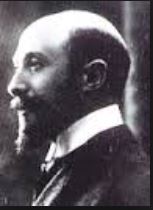
Hippolyte Dreyfus-Barney (April 12, 1873 - December 20, 1928).
French Baha'i from 1901.
Bahaou'llah ; traduction française par Hippolyte Dreyfus.
- L'oeuvre de Bahaou'llah. 01, La Très sainte tablette. Les paroles cachées, les sept vallées du voyage vers Dieu. La lettre sur le Bayan, traduction française par Hippolyte Dreyfus. Paris : E. Leroux, 1923. 176 pp. French translations of several important alwah of Baha'-Allah.
- [I:] La Très Sainte Tablette. Les paroles cachées. Les sept vallées du voyage vers Dieu. La lettre sur le Bayan. 1923. --
[II:] Le temple de Dieu (Souratou'l haykal). Les lettres aux souverains (Alwahi salatin). 1924.
Rozen, Baron Vīktor Romanovīch (1849-1908).
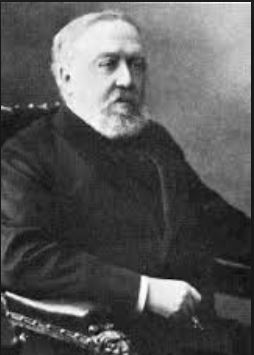
- 1908. al-Majmūʻ al-awwal min rasāʼil al-Shaykh al-Bābī. Bahāʼ Allāh... [= Russian title] Beháullach (Babid), Perwyj sbornik poslanij / Izd. W. Rozen. St. Peterburg, 1908. iv+185pp. Copy in Leiden University Library. So W-Cat.
- [Comp. ] Rasā'il al-Shaykh al-Bābī Bahā Allāh - wa-qad iʿtanī bi-taṣḥīḥahi .... ūn Vīktūr Rawzin. Sanqṭ Biṭirzbūrgh : [Tip. Imp. akademīi nauk], 1908. Copy in British Library.
- On H-Baha'i site : http://www.h-net.org/~bahai/areprint/baha/M-R/R/rosen/rosen.htm
- Cf. Edward Granville Browne.`Some Remarks on the Babi Texts edited by Baron Victor Rosen in Vols. I and VI of the Collections Scientifiques de l'Institut des Langues Orientales de Saint-Petersbourg". Journal of the Royal Asiatic Society Vol. 24 (1892): pages 259-335.
Tumanski, Alexandr Grigoryevich (1861-XXXX).
- Add
- Add ...
Some further Compilations in Translation.
Yūhannā Dāwūd, comp.
- 1914. The River of life, a selection from the teachings... [From the writings of Bahā Allāh and ʻAbdul Bahā']. London, 1914. xvi+62pp.
Ali Kuli Khan, comp. + trans.
- 1917. Tablets of Baha'o'llah Revealed at Acca, Syria: Tablet of Tarazat, Tablet of the World, Words of Paradise, Tablet of Tajalleyat, The Glad Tidings, The Tablet of lshrekat, Preceded by the Tablet on the Most Great Infallibility. trans. Ali Kuli Khan. Chicago: Bahai Publishing Society, 1917. 137 pp. Refer, Collins 1.133. This is a kind of predecessor of TB and TB* (see above)
Holley, Horace, Comp.
- 1923. 2nd ed. Baháʻí Scriptures : selections from the utterances of Baháʻuʻlláh and ʻAbduʻl Bahá. Edited by Horace Holley... 2nd edition. New York : Baháʻí publishing committee (printed by J. J. Little and Ives), xii+576 pp.
ADD.
- 1955. The Bahá'í revelation : a selection from the Bahá'i holy writings / Bahá U'lláh, Abdu'l-Bahá ; including selections from the Bahá'i Holy Writings and talks by Abdu'l-Bahá. London : Bahá'í Publishing Trust, 1955.
Bahā Allāh; The Research Department of the Universal House of Justice.
TB = Tablets of Baha'u'llah revealed after the Kitab-i-Aqdas. Haifa: Baha'i World Centre, 19XX.
- Majmūʻahʼī az alvāḥ-i Jamāl-i Aqdas-i Abhá kih baʻd az kitāb-i aqdas nāzil shudah. Hofheim-Langenheim : Bahāʼī-Verl., 1980. 175-[19] pp.



